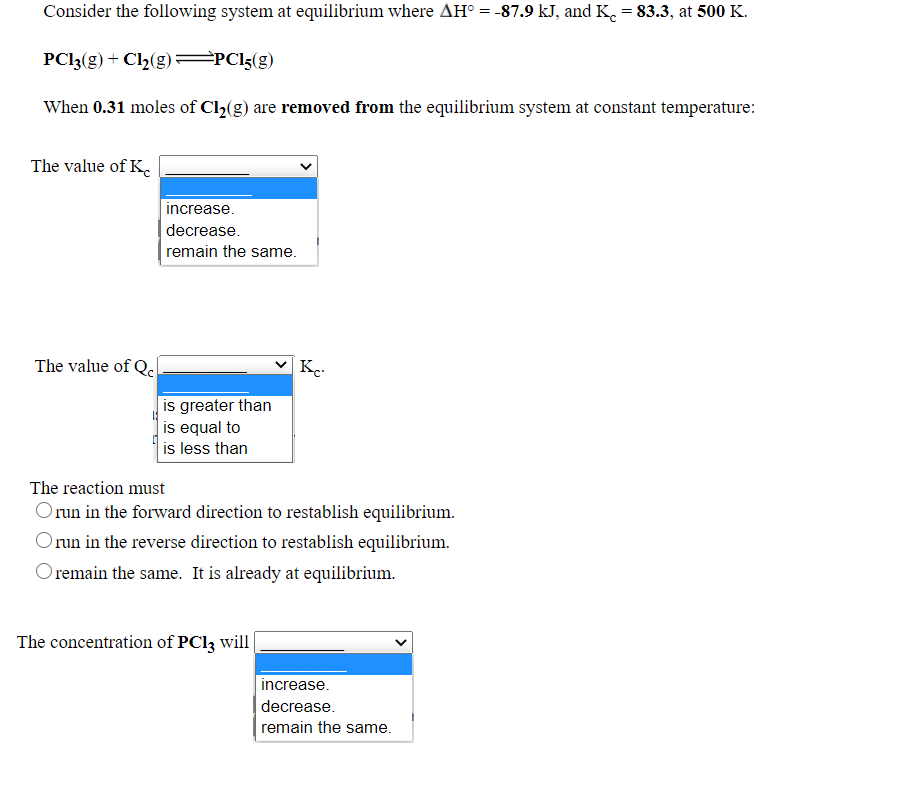Consider the following system at equilibrium where AH° = -87.9 kJ, and K. = 83.3, at 500 K. PC13(g)+ Cl½(g) =PPCI5(g) When 0.31 moles of Cl(g) are removed from the equilibrium system at constant temperature: The value of K. increase. decrease. remain the same. The value of Qc is greater than is equal to is less than The reaction must Orun in the forward direction to restablish equilibrium. Orun in the reverse direction to restablish equilibrium. Oremain the same. It is already at equilibrium. The concentration of PC13 will| increase. decrease. remain the same.
Consider the following system at equilibrium where AH° = -87.9 kJ, and K. = 83.3, at 500 K. PC13(g)+ Cl½(g) =PPCI5(g) When 0.31 moles of Cl(g) are removed from the equilibrium system at constant temperature: The value of K. increase. decrease. remain the same. The value of Qc is greater than is equal to is less than The reaction must Orun in the forward direction to restablish equilibrium. Orun in the reverse direction to restablish equilibrium. Oremain the same. It is already at equilibrium. The concentration of PC13 will| increase. decrease. remain the same.
Chemistry: The Molecular Science
5th Edition
ISBN:9781285199047
Author:John W. Moore, Conrad L. Stanitski
Publisher:John W. Moore, Conrad L. Stanitski
Chapter12: Chemical Equilibrium
Section: Chapter Questions
Problem 6QRT: Indicate whether each statement below is true or false. If a statement is false, rewrite it to...
Related questions
Question

Transcribed Image Text:Consider the following system at equilibrium where AH° = -87.9 kJ, and K. = 83.3, at 500 K.
PC13(g) + Cl2(g) =PCI5(g)
When 0.31 moles of Cl2(g) are removed from the equilibrium system at constant temperature:
The value of K.
increase.
decrease.
remain the same.
The value of Qc
K..
is greater than
is equal to
is less than
The reaction must
Orun in the forward direction to restablish equilibrium.
Orun in the reverse direction to restablish equilibrium.
Oremain the same. It is already at equilibrium.
The concentration of PC13 will
increase.
decrease.
remain the same.
Expert Solution
This question has been solved!
Explore an expertly crafted, step-by-step solution for a thorough understanding of key concepts.
Step by step
Solved in 3 steps with 1 images

Knowledge Booster
Learn more about
Need a deep-dive on the concept behind this application? Look no further. Learn more about this topic, chemistry and related others by exploring similar questions and additional content below.Recommended textbooks for you

Chemistry: The Molecular Science
Chemistry
ISBN:
9781285199047
Author:
John W. Moore, Conrad L. Stanitski
Publisher:
Cengage Learning


Chemistry: An Atoms First Approach
Chemistry
ISBN:
9781305079243
Author:
Steven S. Zumdahl, Susan A. Zumdahl
Publisher:
Cengage Learning

Chemistry: The Molecular Science
Chemistry
ISBN:
9781285199047
Author:
John W. Moore, Conrad L. Stanitski
Publisher:
Cengage Learning


Chemistry: An Atoms First Approach
Chemistry
ISBN:
9781305079243
Author:
Steven S. Zumdahl, Susan A. Zumdahl
Publisher:
Cengage Learning

Chemistry
Chemistry
ISBN:
9781305957404
Author:
Steven S. Zumdahl, Susan A. Zumdahl, Donald J. DeCoste
Publisher:
Cengage Learning

Principles of Modern Chemistry
Chemistry
ISBN:
9781305079113
Author:
David W. Oxtoby, H. Pat Gillis, Laurie J. Butler
Publisher:
Cengage Learning

Chemistry for Engineering Students
Chemistry
ISBN:
9781337398909
Author:
Lawrence S. Brown, Tom Holme
Publisher:
Cengage Learning